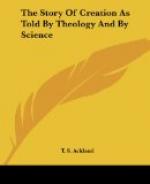not reach the surface, but as they approached it would
be again converted into vapour, and re-ascend to pass
again and again through the same process. But
by this means the intense heat of the nucleus would
be gradually conveyed away, till the cooling reached
a point at which some of the superficial materials
would assume a solid form. It is by no means
certain what is the true primary rock—for
a long time it was almost universally assumed to be
granite, since granite is uniformly found underlying
the oldest sedimentary rocks that are known.
But as these rocks have been forced from their original
position and tilted up, the underlying stratum may
probably be of later date than the upper ones, since
it was the elevating agent. So that we can have
no certain knowledge on this point, since the earliest
sedimentary strata, wherever they retain their original
position, must be at a depth far below the reach of
man. If, however, Sir C. Kyell’s view of
the conditions requisite for the formation of granite
are correct, these conditions [Footnote: Student’s
Geology, chap. xxxi.]—heat, moisture, and
enormous pressure—would all be present at
the surface of the nucleus. Some kind of solid
floor must have been formed before the next stage
could be reached, at which it would be possible for
water to exist in a fluid state. This, however,
would be possible at a much higher temperature than
at present, owing to the enormous atmospheric pressure.
It is possible now, by artificial means, to raise
water, nearly if not quite, to a red heat, without
the formation of steam, and the pressure of the atmosphere
in the case supposed would, in all probability, be
much greater than any which we can now apply under
the conditions necessary for heating the water.
It is probable that at this point the close of the
second day must be placed: but the indications
of the narrative do not enable us to fix it with any
degree of certainty. As, however, from this point
a new series of processes would commence, and those
processes are in intimate connexion with the first
of the two developments ascribed to the third day,
the period when water could first maintain a fluid
form on the earth’s surface, seems to present
the most probable line of demarcation.
Section 6. The third day.
“And God said, Let the waters under the Heaven
be gathered together in one place, and let the dry
land appear; and it was so.
“And God called the dry land Earth, and the
gathering together of the waters called He Seas, and
God saw that it was good.
“And God said, Let the earth sprout sprouts,
the herb seeding seed, and the fruit-tree yielding
fruit after his kind, whose seed is in it, [Footnote:
“It” seems preferable to “itself”
here. The same Hebrew word stands for both, but
if the “fruit-tree” be taken as the antecedent,
which it must be if we translate “itself,”
there seems no meaning in the statement. If we
read “it,” the pronoun will refer to the
fruit—“the tree whose seed is in
its fruit”—which gives an intelligible
sense.] upon the earth, and it was so.




